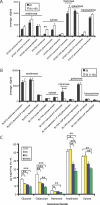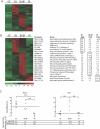Genomic and metabolic studies of the impact of probiotics on a model gut symbiont and host
- PMID: 17132046
- PMCID: PMC1661682
- DOI: 10.1371/journal.pbio.0040413
Genomic and metabolic studies of the impact of probiotics on a model gut symbiont and host
Abstract
Probiotics are deliberately ingested preparations of live bacterial species that confer health benefits on the host. Many of these species are associated with the fermentation of dairy products. Despite their increasing use, the molecular details of the impact of various probiotic preparations on resident members of the gut microbiota and the host are generally lacking. To address this issue, we colonized germ-free mice with Bacteroides thetaiotaomicron, a prominent component of the adult human gut microbiota, and Bifidobacterium longum, a minor member but a commonly used probiotic. Simultaneous whole genome transcriptional profiling of both bacterial species in their gut habitat and of the intestinal epithelium, combined with mass-spectrometric analysis of habitat-associated carbohydrates, revealed that the presence of B. longum elicits an expansion in the diversity of polysaccharides targeted for degradation by B. thetaiotaomicron (e.g., mannose- and xylose-containing glycans), and induces host genes involved in innate immunity. Although the overall transcriptome expressed by B. thetaiotaomicron when it encounters B. longum in the cecum is dependent upon the genetic background of the mouse (as assessed by a mixed analysis of variance [ANOVA] model of co-colonization experiments performed in NMRI and C57BL/6J animals), B. thetaiotaomicron's expanded capacity to utilize polysaccharides occurs independently of host genotype, and is also observed with a fermented dairy product-associated strain, Lactobacillus casei. This gnotobiotic mouse model provides a controlled case study of how a resident symbiont and a probiotic species adapt their substrate utilization in response to one another, and illustrates both the generality and specificity of the relationship between a host, a component of its microbiota, and intentionally consumed microbial species.
Conflict of interest statement
Competing interests. The authors have declared that no competing interests exist.
Figures




Comment in
-
In the gut's microbial community, one plus one equals many (effects).PLoS Biol. 2006 Dec;4(12):e447. doi: 10.1371/journal.pbio.0040447. Epub 2006 Nov 28. PLoS Biol. 2006. PMID: 20076522 Free PMC article. No abstract available.
Similar articles
-
Sulfatases and a radical S-adenosyl-L-methionine (AdoMet) enzyme are key for mucosal foraging and fitness of the prominent human gut symbiont, Bacteroides thetaiotaomicron.J Biol Chem. 2011 Jul 22;286(29):25973-82. doi: 10.1074/jbc.M111.228841. Epub 2011 Apr 20. J Biol Chem. 2011. PMID: 21507958 Free PMC article.
-
A hybrid two-component system protein of a prominent human gut symbiont couples glycan sensing in vivo to carbohydrate metabolism.Proc Natl Acad Sci U S A. 2006 Jun 6;103(23):8834-9. doi: 10.1073/pnas.0603249103. Epub 2006 May 30. Proc Natl Acad Sci U S A. 2006. PMID: 16735464 Free PMC article.
-
Differential Metabolism of Exopolysaccharides from Probiotic Lactobacilli by the Human Gut Symbiont Bacteroides thetaiotaomicron.Appl Environ Microbiol. 2015 Jun 15;81(12):3973-83. doi: 10.1128/AEM.00149-15. Epub 2015 Apr 3. Appl Environ Microbiol. 2015. PMID: 25841008 Free PMC article.
-
Human gut microbiota and bifidobacteria: from composition to functionality.Antonie Van Leeuwenhoek. 2008 Jun;94(1):35-50. doi: 10.1007/s10482-008-9232-4. Epub 2008 Mar 13. Antonie Van Leeuwenhoek. 2008. PMID: 18338233 Review.
-
How host-microbial interactions shape the nutrient environment of the mammalian intestine.Annu Rev Nutr. 2002;22:283-307. doi: 10.1146/annurev.nutr.22.011602.092259. Epub 2002 Apr 4. Annu Rev Nutr. 2002. PMID: 12055347 Review.
Cited by
-
Dominance of Lactobacillus acidophilus in the facultative jejunal Lactobacillus microbiota of fistulated beagles.Appl Environ Microbiol. 2012 Oct;78(19):7156-9. doi: 10.1128/AEM.01975-12. Epub 2012 Jul 27. Appl Environ Microbiol. 2012. PMID: 22843523 Free PMC article.
-
Host response to probiotics determined by nutritional status of rotavirus-infected neonatal mice.J Pediatr Gastroenterol Nutr. 2012 Sep;55(3):299-307. doi: 10.1097/MPG.0b013e31824d2548. J Pediatr Gastroenterol Nutr. 2012. PMID: 22343914 Free PMC article.
-
Commensal bacteria calibrate the activation threshold of innate antiviral immunity.Immunity. 2012 Jul 27;37(1):158-70. doi: 10.1016/j.immuni.2012.04.011. Epub 2012 Jun 14. Immunity. 2012. PMID: 22705104 Free PMC article.
-
Development of the human infant intestinal microbiota.PLoS Biol. 2007 Jul;5(7):e177. doi: 10.1371/journal.pbio.0050177. Epub 2007 Jun 26. PLoS Biol. 2007. PMID: 17594176 Free PMC article.
-
Genomic insights into bifidobacteria.Microbiol Mol Biol Rev. 2010 Sep;74(3):378-416. doi: 10.1128/MMBR.00004-10. Microbiol Mol Biol Rev. 2010. PMID: 20805404 Free PMC article. Review.
References
-
- Bengmark S, Martindale R. Prebiotics and synbiotics in clinical medicine. Nutr Clin Pract. 2005;20:244–261. - PubMed
-
- Molin G. Probiotics in foods not containing milk or milk constituents, with special reference to Lactobacillus plantarum 299v. Am J Clin Nutr. 2001;73:380S–385S. - PubMed
-
- Bach JF. The effect of infections on susceptibility to autoimmune and allergic diseases. N Engl J Med. 2002;347:911–920. - PubMed
-
- Metchnikoff É. In: The prolongation of life. Mitchell PC, translator. New York: Putnam; 1910. 343
Publication types
MeSH terms
Substances
Associated data
- Actions
- Actions
Grants and funding
LinkOut - more resources
Full Text Sources
Other Literature Sources
Molecular Biology Databases

